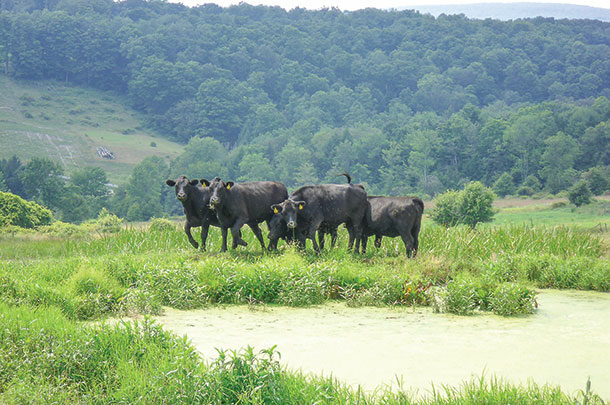Unfortunately, in a summer-long drought, early term abortion of the fetus can occur for a number of reasons. Let’s take a moment to review mycotoxins, nitrates and pesticide residuals and how drought can aggravate an already stressful breeding-feeding season.
Mycotoxins
So who hasn’t seen moldy corn, sprouting small grain heads or black, speckled cornstalk residue? Just about every crop that drowns, falls over from pest damage or is knocked down by high winds is prone to harboring some kind of viral, bacterial or mold-producing pathogen.
Throw in a summer-long drought and mycotoxins are inevitable. In fact, this is such a big issue, more than 400 experts recently met in Manitoba to talk about climatic changes that have aflatoxins, vomitoxin (DON) and zearalenone (ZEN) incidences in feed and processed grains on the increase. Remember, in 2012, aflatoxin-contaminated grain was a big deal because of drought conditions.
Mycotoxins accumulate in the animal’s body and can kill an animal in seven to 35 days if levels become too high. The deadliest toxins are aflatoxin, fumonisin, T-2 toxin, vomitoxin and zearalenone. Animals differ in their reaction to these toxins. The FDA has established guidelines according to livestock species for the maximum toxin level that can be safely fed in processed feed. That’s not quite helpful for those of us feeding as-is products.
So what can one do? Well, for starters, do not turn horses out into moldy grain stubble. They just up and die from the fumonisin toxin from a complication called leukoencephalmalcia. Horses will become disoriented or even deranged.
Others go down with colic, go blind and eventually die. As for other livestock, if you must graze forages that appear moldy or were underwater for any length of time, check out this link (All About feed - Mycotoxin test kits) or send a representative sample to your state mycotoxin testing laboratory.

Don’t forget that ergot poisoning (aka fescue toxicity) is a cumulative exposure issue.
Nitrates and pesticides
The weather and whether you applied fertilizer, manure or just have a high stocking density will bedevil you if your cows aborted because of high nitrates. But pesticides can also be a contributing factor.
If early term abortion has occurred and your animals graze drought-stressed forages, any of these inputs could be suspect, so ask yourself:
Did you apply ammonium or urea-based fertilizers then allow livestock to consume that forage? Normally, we’d expect the crop to utilize all of the fertilizer input and – well, grow. But lack of moisture can cause the nitrate to remain unconverted to protein in the plant stubble.
So regardless of what type of grass or broadleaf crop got the extra nitrogen, it could be excessively high in nitrates during a drought. When the pregnant cow cannot assimilate the high-nitrate forage in her rumen, a situation can occur where blood oxygen levels are depleted, thus causing the death of the fetus.
Did the cattle have access to water containing high amounts of nitrate from manure? The lack of clean water can easily be a cause of abortion issues in a herd.
Was there an excessive amount of weeds in the forage consumed? Most weeds are luxury consumers of available nutrients and often contain excessively high levels of nitrates during periods of prolonged droughts or in situations where they were allowed to grow unchecked.
Did you calculate your pesticide residual correctly? Herbicide carry-over is a real issue in droughty crops. Herbicides, once applied, begin to degrade – at least in a perfect world, with sun and rain. When the rain stops, some of these processes stop – or at least are slowed considerably. Some pesticide labels may have a warning about lack of degradation under adverse conditions like prolonged drought.
Most pesticides have warnings about grazing and feeding restrictions. For example, the Gramoxone (paraquat) label states that if used as a pre- or post-seeding burndown for barley, canary seed, canola, corn (field, sweet and pop types, including crops grown for seed production), dry common beans, field (dry) peas, flax (including low linoleic acid varieties), lentils, mustard, oats, potatoes, rye, soybeans, sunflowers, triticale or wheat fields cannot be grazed or harvested for hay.
Why – you might ask? Well, according to Cornell Extension Toxicology Network, “Paraquat is highly toxic to animals by all routes of exposure and is labeled with a DANGER-POISON signal word.
A single large dose, administered orally or by injection to animals, can cause excitability and lung congestion, which in some cases leads to convulsions, incoordination and death by respiratory failure.”
- Bromoxynil (Buctril) also states: Small grains should not be grazed within 45 days of treatment.
- 2, 4-D and dicamba (Banvel, Clarity) products have 30- to 70-day grazing restrictions for lactating animals whose milk will be consumed by humans. The wording on the Banvel label even states that animals cannot be removed from the treated area for slaughter prior to 30 days after last application.
- Other commonly applied herbicides with grazing restrictions include triclopyr, clopyralid, aminopyralid and tebuthirion. Many fungicides and insecticides also have grazing and haying interval restrictions. In a prolonged drought situation, I would recommend extending these minimal restrictions just to be sure.
While research presented at the Federation of Animal Science Societies (FASS) on feeding transgenic crops to livestock has alleviated some producers’ concerns that grazing genetically altered crop material, enhanced to be tolerant to certain herbicide chemistries or insect feeding, might alter cattle performance or interfere with reproductive efficiency, the issue of pesticide residues in milk and manure remains. ![]()
For additional resources see: The Agronomy Guide.
PHOTO 1: During a prolonged drought, stagnant water can contain high levels of nitrates and bacterial pathogens that can negatively impact herd health.
PHOTO 2: If you must graze moldy forages, send a representative sample to a mycotoxin testing laboratory before turnout. Photos by Melissa Bravo.

-
Melissa Bravo
- Certified Crop Adviser and Herd Health Specialist
- Meadow Lake Farm Consulting
- Email Melissa Bravo











